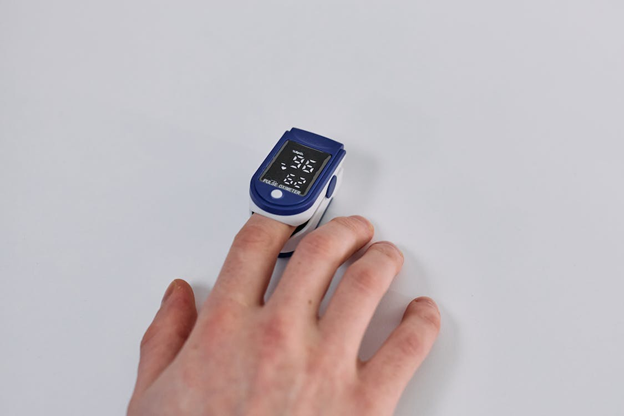Oxygen saturation is a key indicator of how efficiently the lungs function. Our lungs transmit oxygen from the air we breathe into small blood vessels.
These blood vessels provide oxygen-rich blood to the heart, which then pumps it through the arteries to every part of the body. To function effectively, our organs require a constant supply of oxygen.
But if the lungs’ ability to carry oxygen into the blood is impaired, blood oxygen saturation decreases, thereby endangering our organs. This decline can be detected with pulse oximeters, which notify patients of the need for immediate medical attention.
This blog post discusses pulse oximeters’ role in monitoring oxygen levels and our respiratory health.
What are pulse oximeters?

Pulse oximeters, also known as Pulse Ox, is a small electronic device that resembles big clothespin or chip clip that can be attached to a patient’s finger. It measures the oxygen saturation carried by the red blood cells.
You can put pulse oximeters on your fingers, forehead, nose, foot, ears, or toes. Upon inserting your finger, it immediately lights up and shows numbers indicating your blood oxygen saturation and heart rate.
The average oxygen value for a healthy person is between 95 and 98 percent. Some individuals with pre-existing medical issues might have a lower normal reading. You should visit your doctor if the reading drops to 93 or 92 percent or even lower.
On the other hand, an adult’s resting heart rate ranges from 60 to 100 beats per minute., while athletes with greater cardiovascular fitness have a lower pulse.
Your doctor may recommend a pulse oximeter if you have a lung or heart issue or experience symptoms like shortness of breath etc.
You can dispose of or recycle the pulse oximeter. If you’re using it at home, it’s advisable to let your doctor know before throwing it away because it might be reusable.
Why would I need a pulse oximetry test?
When your doctor suspects that your blood oxygen levels may be too low, they will use a pulse oximeter to confirm their suspicions. The device is used to:
- Detect symptoms like shortness of breath
- Monitor blood oxygen level during any surgery
- Check oxygen level when a patient is on supplementary oxygen
- Determine whether a person needs breathing assistance
- Assess the usefulness of a ventilator
- Monitor oxygen levels during or after sedation-needed surgery
- Assess whether a patient requires supplemental oxygen therapy
- Determine a person’s tolerance for more rigorous exercise
- Conduct a sleep study to determine if a person has sleep apnea
Also, you may require this test if you have the following illnesses below:
- Pneumonia
- Chronic Obstructive Pulmonary Disease (COPD)
- Lung cancer
- Heart attack or heart failure
- Sleep apnea
- Asthma
- Congenital heart disease
What to expect?
With the oximeter, you should expect a simple, fast, and safe measurement of your body’s oxygen saturation level.
This test could be conducted when admitted to a hospital facility or at a doctor’s visit. A nurse will place a tiny, clip-like pulse oximeter on your finger, toe, or ear. Alternately, a disposable sticky probe can be applied to these areas to ascertain your respiratory health.
Once the probe is in place, pulse oximeters show the heart rate as well as oxygen saturation level in a matter of seconds.
The process of taking an oximetry reading is short, painless, and non-invasive, thereby involving no needles or discomfort.
A pulse oximeter uses a unique type of light to determine the quantity of oxygen in the red blood cells moving through the blood arteries beneath your skin.
And by analyzing this light that passes through the finger, it can determine the percentage of oxygen in the red blood cell.
Your nurse will remove the clip if it’s only a one-time check unless you need to stay in the hospital longer for more monitoring. And you discuss with your doctor the next course of action regarding treatment.
How to take the reading
Both inpatients and outpatients can benefit from pulse oximetry. In some circumstances, your doctor could advise getting a pulse oximeter for use at home.
Below are the steps to use a pulse oximeter. They are as follows:
- Take off any jewelry
- Remove any nail polish
- If you decide to attach the device to your hand, ensure your hand is warm, relaxed, and below heart level.
- Put the device on your toe, earlobe, or finger.
- As long as necessary, keep the device on to monitor your pulse and oxygen saturation.
- Remove the device once the test is over.
Home use
Some individuals with peculiar health conditions use pulse oximeters at home. These home-use oximeters are of two types. They include:
a. Over-the-counter oximeters
Most people use over-the-counter pulse oximeters. You can get them both online and in-store. And some of them can connect to your phone’s apps.
The FDA discourages the use of over-the-counter oximeters for medical conditions and, as such, does not review them.
b. Prescription oximeters
Medical facilities and hospitals use this same oximeter. You can own one based on your doctor’s prescription. The FDA examines prescription oximeters to ensure that their accuracy is within acceptable range.
The price of pulse oximeters sold over-the-counter ranges from $15 to $80, while that of prescription oximeters is higher.
Pulse oximetry readings
Pulse oximetry tests give an estimate of blood oxygen levels which are often precise. This is true when using those prescription oximeters used in the majority of hospitals and medical offices. These tools allow medical personnel to perform the tests correctly.
Prescription oximeters are required by the Food and Drug Administration (FDA) to produce readings with a level of accuracy.
According to the American Thoracic Society, more than 89 percent of our blood should carry oxygen. This is the level of oxygen saturation required to maintain the health of your cells.
If your blood oxygen level is below 89%, your body may not be receiving as much oxygen as it needs. And you might need to use a tube to breathe in more oxygen.
Temporarily falling below this oxygen saturation level might not harm you. However, prolonged or consistent low oxygen saturation levels can be harmful. But for the majority of healthy individuals, a 95 percent oxygen saturation level is considered normal.
However, a pulse oximeter reading is just an estimate. For instance, a 90% oxygen saturation measurement on a prescription device certified by the FDA could indicate anything between 86% and 94%.
What Factors Affect the Accuracy of Oximeter Readings
Some factors include:
- Poor blood flow
- A coat of nail polish
- Filthy or long fingernails
- Tobacco use
- Various pulse oximeter sensors (adhesive vs. finger clip)
- Skin thickness
- Skin temperature
- Skin color
In terms of skin color, a 2020 report compared the effectiveness of measures of arterial blood gas and pulse oximetry tests in determining hypoxemia in Black and White individuals.
It was discovered that there were about three times instances among Black patients where blood gas measures picked up occult hypoxemia but pulse oximetry testing did not. This reveals that these tests did not consider different skin tones to eliminate racial bias.
Additional signs of low oxygen levels include:
- Difficult in breathing
- Bluish lips, nails, or skin color
- Racing pulse
- Chest tightness or pain
- A persistent cough that worsens with time
- Uneasy and restless sensation
The reading on your pulse oximeter is simply one of many indicators of your respiratory health. Discuss with your doctor about any symptoms.
It’s also crucial to understand that not everyone with low oxygen levels will experience any symptoms. Only a doctor can diagnose if you have low oxygen levels.
Are there any risks associated with pulse oximeters?
The pulse oximetry test is safe and has no attendant risks. However:
- Your skin may become occasionally irritated by the sticky substance on the probe.
- You might only get an accurate result if you or your nurse attach the sensor properly.
Ways to increase blood oxygen levels
Blood oxygen levels can be increased naturally in a number of ways. They are as follows:
i. Breath in fresh air
Going on a walk or opening your windows can boost the amount of oxygen you inhale. This will increase the level of oxygen in your blood.
ii. Quit smoking
You’ll notice significant improvements in your oxygen circulation in about two to three weeks when you stop smoking.
Symptoms like shortness of breath will also reduce after one to nine months. This enables your body to absorb more oxygen.
iii. Engage in breathing exercises
Breathing exercises open the airways, increasing oxygen in your blood. So endeavor to engage in simple breathing exercises like pursed-lip and deep belly breathing.
Conclusion
This blog post shows that our body’s oxygen level indicates our overall respiratory health. And to function effectively, our organs require a constant supply of oxygen.
Pulse oximeters are, therefore, an effective means of monitoring blood oxygen levels and heart rate. These electronic devices are simple, non-invasive, safe, and improve our general well-being.
- Manual vs. Automated Cleaning Equipment: Which Should You Choose? - December 15, 2023
- Cost Efficiency of Investing in Professional Cleaning Equipment - December 8, 2023
- Safety Precautions When Using Professional Cleaning Equipment - November 26, 2023
